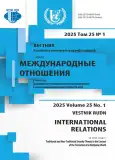“Green” Security: NATO’s Climate Change Adaptation Strategy
- Authors: Timakova O.A.1
-
Affiliations:
- Diplomatic Academy, MFA of Russia
- Issue: Vol 25, No 1 (2025): Traditional and Non-Traditional Security Threats in the Context of the Formation of a Multipolar World
- Pages: 98-108
- Section: INTERNATIONAL SECURITY
- URL: https://journal-vniispk.ru/2313-0660/article/view/320656
- DOI: https://doi.org/10.22363/2313-0660-2025-25-1-98-108
- EDN: https://elibrary.ru/KOOFQM
- ID: 320656
Cite item
Abstract
At the Brussels Summit in 2021, North Atlantic Treaty Organization (NATO) heads of state and government endorsed the Climate Change and Security Action Plan, which, according to experts, sets an ambitious goal of transforming the alliance into a leading environmental security organization capable of developing adequate adaptation measures to reduce the security impacts of climate change. The article examines the main challenges that the alliance faces in implementing the two tracks of its climate policy. Despite the significant role of the alliance’s member countries in shaping the international climate agenda, the organization’s contribution to the global climate discourse has long remained limited. The article questions the effectiveness of the bloc’s actions in combating climate change; since they are they are aimed at adapting to climate change rather than mitigating its effects. Studying the potential for the use of renewable energy sources in NATO, the article concludes that the development of innovative technologies is inadequate, as are the infrastructural and logistical problems associated with their implementation. The alliance countries have expressed their intention to transition to sustainable energy and to cease their reliance on energy resources from Russia, which could potentially lead to an even greater dependence on supplies of rare earth metals from China. Based on the methods of qualitative and quantitative analysis, the article substantiates that the climate agenda does not correspond to the real actions of the bloc, as evidenced by the increase in military spending and arms supplies to Ukraine. New member countries of the alliance, Sweden and Finland, which are leading the implementation of the United Nations sustainable development goals, are also ready to increase their national greenhouse gas emissions through participation in NATO and increase defense spending in accordance with the requirements of the alliance. The author concludes that although NATO wants to become the first international military-political organization whose policy is aimed at reducing the impact of climate change on security, the actions and goals of the alliance continue to be controversial. The author further predicts an escalating call from international non-state actors for greater climate action within the alliance.
Keywords
About the authors
Olga A. Timakova
Diplomatic Academy, MFA of Russia
Author for correspondence.
Email: o.timakova@dipacademy.ru
ORCID iD: 0000-0003-4185-0194
SPIN-code: 3347-6915
PhD (Political Science), Associate Professor, Department of Political Science and Political Philosophy
Moscow, Russian FederationReferences
- Badeeb, R., Lean, H., & Clark, J. (2017). The evolution of the natural resource curse thesis: A critical literature survey. Resources Policy, 51, 123-134. https://doi.org/10.1016/j.resourpol.2016.10.015
- Barnett, J. (2001). The meaning of environmental security: Ecological politics and policy in the new security era. London: Zed Books.
- Black, R., Busby, J., Dabelko, G. D., de Coning, C., & Maalim, H. et al. (2022). Environment of peace: Security in a new era of risk. Stockholm: SIPRI. https://doi.org/10.55163/LCLS7037
- Buzan, B., Wæver, O., & de Wilde, J. (1998). Security: A new framework for analysis. Boulder, London: Lynne Rienner Publishers.
- Causevic, A. (2017). Facing an unpredictable threat: Is NATO ideally placed to manage climate change as a non-traditional threat multiplier? Connections: The Quarterly Journal, 16(2), 59-80. https://doi.org/10.11610/Connections.16.2.04
- Depledge, D. (2023). Low-carbon warfare: Climate change, net zero and military operations. International Affairs, 99(2), 667-685. https://doi.org/10.1093/ia/iiad001; EDN: MBOGPT
- Fennell, P., Driver, J., Bataille, Ch., & Davis, S. (2022). Cement and steel - nine steps to net zero. Nature, 603, 574-577. https://doi.org/10.1038/d41586-022-00758-4; EDN: NIQRHE
- Homer-Dixon, T. F. (1994). Environmental scarcities and violent conflict: Evidence from Cases. International Security, 19(1), 5-40. https://doi.org/10.2307/2539147; EDN: HIGBVB
- Jalili, D. (2022). Enhancing military sustainability through education: Balancing quick wins with systemic behavioural change. In G. Iacovino, M. Wigell (Eds.), Innovative technologies and renewed policies for achieving a greener defence (pp. 95-112). Dordrecht: Springer. https://doi.org/10.1007/978-94-024-2186-6_8
- Kertysova, K. (2023). Towards a greener alliance. In T. Clack, Z. Meral, L. Selisny (Eds.), Climate change, conflict, and (in)security: Hot war (pp. 171-188). London: Routledge. https://doi.org/10.4324/9781003377641
- Lippert, T. H. (2019). NATO, climate change, and international security: A risk governance approach. Cham: Palgrave Macmillan. https://doi.org/10.1007/978-3-030-14560-6
- Lovins, A. B. (2010). DOD’s energy challenge as strategic opportunity. Joint Forces Quarterly, (57), 33-42.
- Mach, K. J., Kraan, C. M., Adger, W. N., Buhaug, H., & Burke, M. et al. (2019). Climate as a risk factor for armed conflict. Nature, 571, 193-197. https://doi.org/10.1038/s41586-019-1300-6; EDN: GUJRRN
- Milburn, R. (2023). Carbon warriors: Enhancing NATO’s response to climate change. The RUSI Journal, 168(4), 30-39. https://doi.org/10.1080/03071847.2023.2235152; EDN: RCXAUE
- Neimark, B., Belcher, O., Ashworth, K. & Larbi, R. (2024). Concrete impacts: Blast walls, wartime emissions, and the US occupation of Iraq. Antipode, 56(3), 983-1005. https://doi.org/10.1111/anti.13006; EDN: VROFCH
- Turner, J. & Bailey, D. (2022). ‘Ecobordering’: Casting immigration control as environmental protection. Environmental Politics, 31(1), 110-131. https://doi.org/10.1080/09644016.2021.1916197; EDN: CMVDQH
Supplementary files









